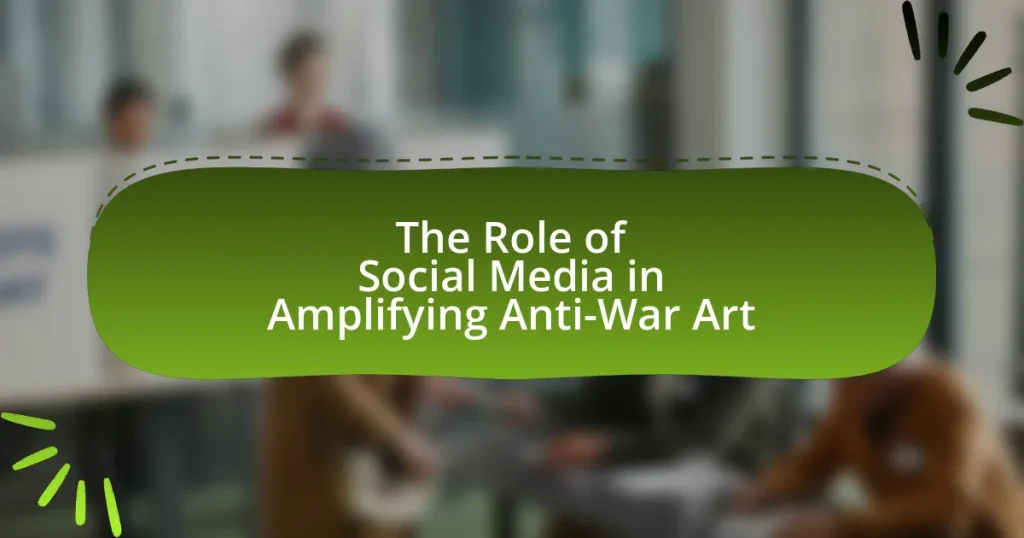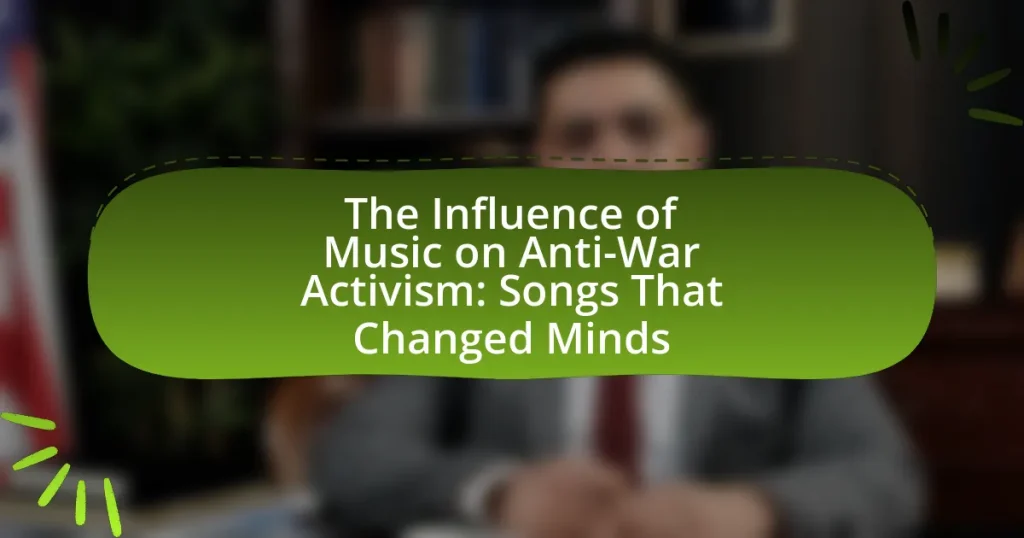The article examines the significant role of poetry in anti-war movements throughout history, highlighting how poets have used their works to express dissent and human suffering. It discusses notable poets such as Wilfred Owen, Siegfried Sassoon, Allen Ginsberg, and Denise Levertov, who articulated the brutal realities of war and challenged glorified narratives. The article also explores the emotional impact of poetry on audiences, the evolution of anti-war themes, and the challenges faced by contemporary poets in promoting their messages. Additionally, it addresses how poetry influences public perception of war and fosters community among activists.
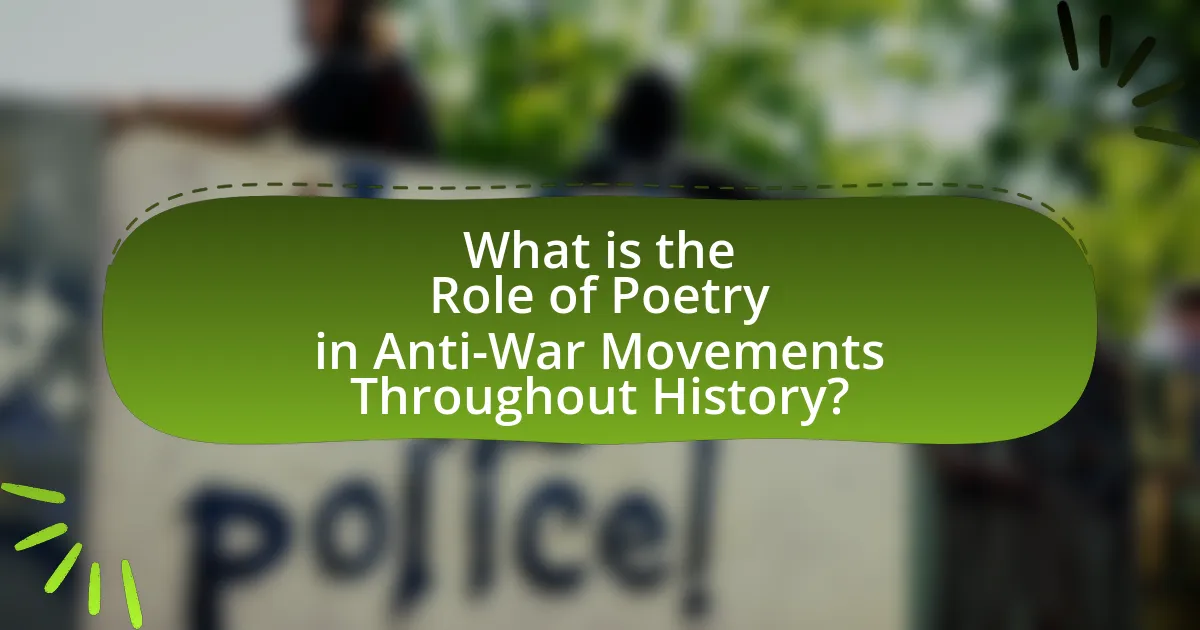
What is the Role of Poetry in Anti-War Movements Throughout History?
Poetry has played a significant role in anti-war movements throughout history by serving as a powerful medium for expressing dissent and human suffering. Poets like Wilfred Owen and Siegfried Sassoon during World War I used their works to convey the brutal realities of war, challenging the glorification of combat and highlighting the emotional and physical toll on soldiers. Their poems, such as Owen’s “Dulce et Decorum Est,” vividly depict the horrors of battle, influencing public perception and fostering anti-war sentiment. Additionally, during the Vietnam War, poets like Allen Ginsberg and Denise Levertov articulated the moral and ethical dilemmas associated with military conflict, galvanizing opposition through their evocative language and imagery. This historical context demonstrates that poetry not only reflects societal attitudes towards war but also actively shapes and mobilizes anti-war movements by resonating with the collective conscience and inspiring action against violence.
How has poetry been used as a tool for anti-war sentiment?
Poetry has been used as a powerful tool for anti-war sentiment by articulating the emotional and psychological impacts of war, thereby fostering public dissent. Notable examples include Wilfred Owen’s “Dulce et Decorum Est,” which vividly depicts the horrors of World War I, challenging the glorification of war and exposing its brutal realities. Additionally, poets like Allen Ginsberg in “Howl” criticized the Vietnam War, reflecting societal disillusionment and urging a collective response against militarism. These works resonate with audiences, mobilizing them to question and oppose war through evocative imagery and poignant language, thus solidifying poetry’s role in anti-war movements throughout history.
What historical contexts have seen poetry as a form of protest?
Poetry has served as a form of protest in various historical contexts, notably during the Vietnam War, the Civil Rights Movement, and the anti-apartheid struggle in South Africa. During the Vietnam War, poets like Allen Ginsberg and Denise Levertov used their work to criticize U.S. involvement and advocate for peace, reflecting widespread public dissent. In the Civil Rights Movement, figures such as Maya Angelou and Langston Hughes employed poetry to highlight racial injustices and inspire activism, contributing to the broader fight for equality. Similarly, South African poets like Antjie Krog and Sipho Sepamla articulated the struggles against apartheid through their verses, galvanizing international support and awareness. These examples illustrate how poetry has historically been a powerful medium for expressing dissent and mobilizing social change.
How do poets convey anti-war messages through their work?
Poets convey anti-war messages through vivid imagery, emotional language, and personal narratives that highlight the horrors and futility of war. For instance, Wilfred Owen’s poem “Dulce et Decorum Est” uses graphic descriptions of soldiers suffering in battle to challenge the glorification of war, illustrating the physical and psychological trauma experienced by combatants. Additionally, poets often employ symbolism and metaphor to critique political motives behind wars, as seen in the works of poets like Langston Hughes, who addressed racial injustices linked to military conflicts. By drawing on personal experiences and societal observations, poets effectively communicate the devastating impact of war, fostering empathy and encouraging anti-war sentiments among readers.
Why is poetry an effective medium for expressing anti-war ideas?
Poetry is an effective medium for expressing anti-war ideas because it conveys complex emotions and critiques of war in a concise and impactful manner. The use of imagery, metaphor, and rhythm allows poets to evoke strong feelings and provoke thought, making the horrors and consequences of war more relatable and visceral. Historical examples, such as Wilfred Owen’s “Dulce et Decorum Est,” illustrate the brutal realities of combat, challenging the glorification of war and influencing public perception. Additionally, poetry can transcend cultural and linguistic barriers, reaching a wider audience and fostering empathy, as seen in the works of poets like Pablo Neruda and Langston Hughes, who addressed the human cost of conflict.
What emotional impact does poetry have on its audience?
Poetry evokes profound emotional responses in its audience, often serving as a catalyst for empathy and reflection. Through vivid imagery and personal narratives, poetry can articulate the pain, loss, and hope associated with war, fostering a deeper understanding of the human experience. For instance, the works of poets like Wilfred Owen and Maya Angelou have historically highlighted the emotional toll of conflict, prompting readers to confront the harsh realities of war and its impact on individuals and society. This emotional engagement can lead to increased awareness and motivation for social change, as poetry resonates on a personal level, making abstract concepts of war tangible and relatable.
How does the use of language in poetry enhance its anti-war message?
The use of language in poetry enhances its anti-war message by employing vivid imagery, emotional resonance, and powerful metaphors that evoke strong feelings against the horrors of war. For instance, poets like Wilfred Owen utilize stark and graphic language to depict the brutal realities of combat, as seen in his poem “Dulce et Decorum Est,” where he describes the suffering of soldiers in a way that challenges glorified notions of warfare. This evocative language not only captures the physical and psychological trauma experienced by individuals but also fosters empathy in readers, compelling them to reconsider the justification of war. Historical examples, such as the anti-war poems from the Vietnam War era, further illustrate how language can mobilize public sentiment against military conflict, making the emotional impact of poetry a crucial tool in anti-war advocacy.
What are some notable examples of poetry in anti-war movements?
Notable examples of poetry in anti-war movements include “Dulce et Decorum Est” by Wilfred Owen, which critiques the glorification of war and exposes its brutal realities, and “The Waste Land” by T.S. Eliot, reflecting the disillusionment following World War I. Additionally, “The Soldier” by Rupert Brooke presents a romanticized view of sacrifice, which was later challenged by poets like Owen. These works collectively highlight the emotional and psychological impacts of war, serving as powerful critiques of militarism and advocating for peace.
Who are the key poets associated with anti-war poetry?
Key poets associated with anti-war poetry include Wilfred Owen, Siegfried Sassoon, and Langston Hughes. Wilfred Owen is renowned for his poignant depictions of the horrors of World War I, particularly in poems like “Dulce et Decorum Est,” which critiques the glorification of war. Siegfried Sassoon, also a World War I veteran, used his poetry to express disillusionment with the war, exemplified in works such as “Counter-Attack.” Langston Hughes, while primarily known for his contributions to the Harlem Renaissance, addressed the impact of war on African Americans and social justice in poems like “Let America Be America Again.” These poets have significantly shaped the discourse around war through their powerful and evocative writing.
What specific poems have had a significant impact on public opinion regarding war?
“Do Not Go Gentle into That Good Night” by Dylan Thomas significantly impacted public opinion regarding war by emphasizing the struggle against death and the importance of fighting for life. This poem resonated during the Vietnam War era, where its themes of resistance and defiance were interpreted as a call to oppose the war. Additionally, “The Charge of the Light Brigade” by Alfred Lord Tennyson highlighted the futility and tragedy of war, influencing perceptions of military conflicts, particularly the Crimean War. Both poems serve as poignant reflections on the human cost of war, shaping public sentiment and fostering anti-war attitudes.
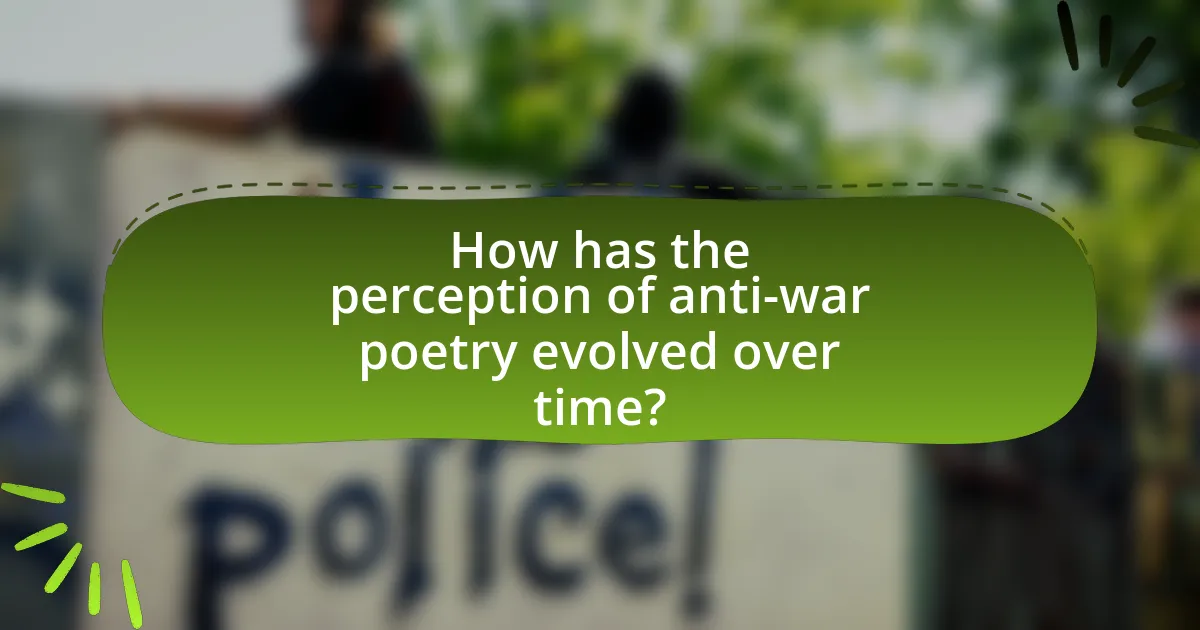
How has the perception of anti-war poetry evolved over time?
The perception of anti-war poetry has evolved from being marginalized to gaining significant recognition as a powerful form of protest. Initially, during conflicts such as World War I, anti-war poetry was often dismissed or criticized for its perceived lack of patriotism. However, as societal attitudes shifted, particularly during the Vietnam War, anti-war poetry began to be embraced as a legitimate and impactful means of expressing dissent. This shift was marked by the works of poets like Allen Ginsberg and Adrienne Rich, who articulated the emotional and moral complexities of war, resonating with a broader audience. The increasing acceptance of anti-war poetry reflects a growing recognition of its role in shaping public discourse and influencing perceptions of war, as evidenced by its inclusion in educational curricula and literary discussions.
What changes have occurred in the themes of anti-war poetry throughout history?
The themes of anti-war poetry have evolved significantly throughout history, reflecting changing societal attitudes towards war. Initially, anti-war poetry, such as that from the Romantic period, often focused on the glorification of nature and the horrors of war, emphasizing individual suffering and the loss of innocence. For example, poets like William Wordsworth and Lord Byron highlighted the emotional and psychological impacts of conflict.
During the World Wars, anti-war poetry shifted to a more direct critique of militarism and the futility of war, as seen in the works of Wilfred Owen and Siegfried Sassoon, who used graphic imagery to convey the brutal realities faced by soldiers. This period marked a transition towards a more collective voice, addressing the broader societal consequences of war.
In contemporary times, anti-war poetry has expanded to include themes of global conflict, imperialism, and the impact of war on marginalized communities. Poets like Warsan Shire and Brian Turner incorporate personal narratives and cultural perspectives, reflecting a more diverse range of experiences and critiques of modern warfare. This evolution illustrates how anti-war poetry has adapted to the historical context and societal changes, continually serving as a powerful medium for protest and reflection on the human cost of conflict.
How did the World Wars influence the style and content of anti-war poetry?
The World Wars significantly influenced the style and content of anti-war poetry by introducing stark realism and emotional depth, reflecting the brutal realities of warfare. Poets like Wilfred Owen and Siegfried Sassoon, who wrote during World War I, employed vivid imagery and personal experiences to convey the horrors of battle, moving away from romanticized depictions of war. This shift is evident in Owen’s poem “Dulce et Decorum Est,” which graphically describes the physical and psychological trauma faced by soldiers, challenging the glorification of war. Similarly, World War II poets, such as W.H. Auden and Stephen Spender, continued this trend by focusing on the moral implications of conflict and the impact on civilian life, as seen in Auden’s “September 1, 1939.” The wars prompted a collective questioning of nationalism and heroism, leading to a more critical and introspective approach in anti-war poetry.
What role did the Vietnam War play in shaping modern anti-war poetry?
The Vietnam War significantly influenced modern anti-war poetry by providing a poignant backdrop for poets to express dissent and critique militarism. This conflict, marked by widespread public opposition and media coverage, inspired poets like Allen Ginsberg and Adrienne Rich to articulate the emotional and moral complexities of war. The vivid imagery and personal narratives in their works reflect the disillusionment felt by many Americans, as seen in Ginsberg’s “Howl,” which captures the anguish of a generation. The war’s brutality and the anti-war movement’s fervor led to a surge in poetry that challenged government narratives and highlighted the human cost of conflict, establishing a lasting legacy in the genre.
How do contemporary poets address anti-war themes?
Contemporary poets address anti-war themes by employing personal narratives, vivid imagery, and emotional resonance to critique the impact of war on individuals and society. For instance, poets like Warsan Shire and Brian Turner use their works to highlight the human cost of conflict, often drawing from their own experiences or those of marginalized communities affected by war. Shire’s poem “Home” powerfully illustrates the trauma of displacement, while Turner’s “Here, Bullet” reflects on the visceral realities faced by soldiers. These poets utilize language that evokes empathy and challenges readers to confront the harsh truths of warfare, thereby reinforcing the anti-war message through relatable and poignant storytelling.
What new forms and styles are being used in modern anti-war poetry?
Modern anti-war poetry employs innovative forms and styles such as multimedia integration, spoken word, and social media platforms. These approaches enhance emotional impact and accessibility, allowing poets to reach diverse audiences. For instance, poets like Warsan Shire utilize spoken word to convey personal narratives that resonate with contemporary experiences of conflict, while others incorporate visual elements and digital formats to engage readers in a more immersive way. This evolution reflects a shift towards inclusivity and immediacy in addressing the complexities of war, as seen in the rise of online poetry communities that facilitate rapid sharing and collaboration.
How do current global conflicts inspire contemporary anti-war poets?
Current global conflicts inspire contemporary anti-war poets by providing them with urgent themes and emotional depth to address the human cost of war. Poets draw from the realities of ongoing wars, such as those in Syria and Ukraine, to highlight the suffering of civilians, the futility of violence, and the need for peace. For instance, the Syrian civil war has led poets like Marwan Makhoul to express the pain of displacement and loss, using their work to advocate for empathy and understanding. This direct engagement with contemporary issues allows poets to resonate with audiences, making their messages more impactful and relevant in the context of current events.
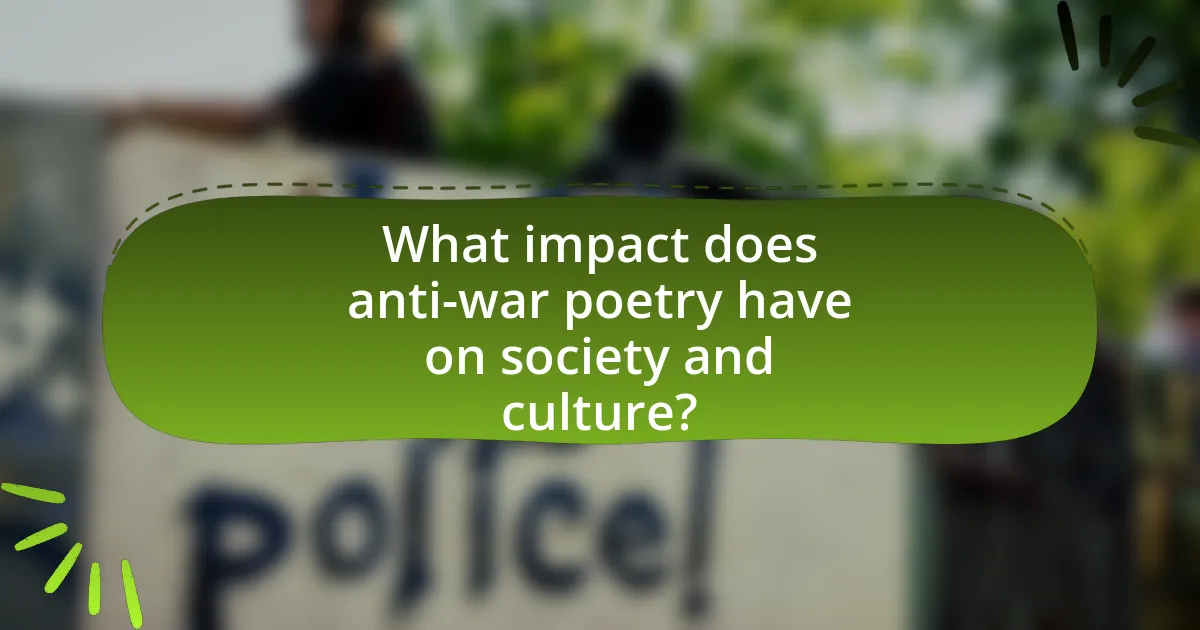
What impact does anti-war poetry have on society and culture?
Anti-war poetry significantly influences society and culture by shaping public perception and fostering anti-war sentiments. This genre of poetry often articulates the emotional and psychological toll of war, compelling readers to confront the harsh realities of conflict. For instance, works like Wilfred Owen’s “Dulce et Decorum Est” vividly depict the brutal experiences of soldiers, challenging glorified narratives of warfare. Such poetry has historically mobilized public opinion against wars, as seen during the Vietnam War when poets like Allen Ginsberg and Adrienne Rich used their verses to critique U.S. involvement, contributing to a broader anti-war movement. The emotional resonance of anti-war poetry not only raises awareness but also encourages cultural reflection on the consequences of violence, ultimately fostering a more peace-oriented societal mindset.
How does poetry influence public perception of war?
Poetry influences public perception of war by evoking emotional responses and providing personal narratives that challenge official narratives. Through vivid imagery and poignant language, poets like Wilfred Owen and Maya Angelou have depicted the harsh realities of conflict, thereby shaping public sentiment against war. For instance, Owen’s “Dulce et Decorum Est” exposes the gruesome experiences of soldiers in World War I, countering the glorified view of warfare prevalent at the time. This emotional resonance can mobilize public opinion, fostering anti-war sentiments and encouraging activism. Historical evidence shows that poetry has played a significant role in movements such as the Vietnam War protests, where works by poets like Allen Ginsberg galvanized opposition to military actions.
What role does poetry play in shaping political discourse around war?
Poetry plays a significant role in shaping political discourse around war by providing a powerful medium for expressing dissent and humanizing the experiences of conflict. Through evocative language and imagery, poets can articulate the emotional and psychological impacts of war, influencing public perception and fostering empathy. For instance, the works of poets like Wilfred Owen during World War I vividly depicted the horrors of trench warfare, challenging glorified narratives of battle and prompting societal reflection on the true costs of war. This ability to convey complex emotions and critique political decisions makes poetry an essential tool in anti-war movements, as it can mobilize public sentiment and inspire activism against militarism.
How can poetry foster community and solidarity among anti-war activists?
Poetry can foster community and solidarity among anti-war activists by providing a shared language and emotional resonance that unites individuals around common values and experiences. Through collective readings, performances, and the dissemination of poetic works, activists can create a sense of belonging and mutual support, reinforcing their commitment to peace and justice. Historical examples, such as the use of poetry during the Vietnam War protests, illustrate how verses like those of Allen Ginsberg and Maya Angelou galvanized public sentiment and connected diverse groups in their opposition to war. This shared artistic expression not only amplifies individual voices but also cultivates a collective identity, essential for sustaining movements against militarism.
What are the challenges faced by anti-war poets today?
Anti-war poets today face significant challenges, including censorship, societal apathy, and the commercialization of art. Censorship can manifest through governmental restrictions or self-censorship due to fear of backlash, limiting the expression of dissenting views. Societal apathy towards war and its consequences often results in a lack of audience engagement, making it difficult for poets to resonate with the public. Additionally, the commercialization of art can dilute the potency of anti-war messages, as poets may feel pressured to conform to market demands rather than convey authentic critiques of war. These challenges hinder the effectiveness of anti-war poetry in promoting peace and social change.
How do censorship and political climate affect the dissemination of anti-war poetry?
Censorship and political climate significantly hinder the dissemination of anti-war poetry by restricting freedom of expression and limiting access to dissenting voices. In authoritarian regimes, for instance, governments often impose strict censorship laws that prevent the publication and distribution of works that criticize military actions or government policies, as seen in countries like North Korea and China. This suppression leads to a lack of visibility for anti-war poetry, as poets may face persecution or imprisonment for their work. Additionally, during times of heightened nationalism or war, societal pressures can discourage the sharing of anti-war sentiments, further isolating poets and their messages. Historical examples include the suppression of anti-war literature during the Vietnam War era in the United States, where many poets faced backlash for their views, illustrating how the political climate can create an environment hostile to dissenting artistic expressions.
What obstacles do poets encounter in reaching their audience?
Poets encounter several obstacles in reaching their audience, including limited access to publishing platforms, societal indifference, and the challenge of conveying complex emotions succinctly. Limited access to publishing platforms restricts poets’ ability to share their work widely; for instance, traditional publishing often favors commercially viable content over artistic expression. Societal indifference can stem from a general lack of interest in poetry, particularly in contexts where other forms of media dominate, making it difficult for poets to engage potential readers. Additionally, the challenge of conveying complex emotions succinctly can hinder poets from effectively communicating their messages, especially in anti-war movements where nuanced perspectives are crucial. These obstacles collectively impede poets’ efforts to connect with their intended audience.
What practical steps can poets take to promote anti-war messages effectively?
Poets can effectively promote anti-war messages by utilizing public readings, social media platforms, and collaborations with activist organizations. Public readings allow poets to engage directly with audiences, fostering emotional connections to their messages. Social media platforms enable poets to reach a wider audience quickly, sharing their work and sparking discussions around anti-war themes. Collaborating with activist organizations can amplify their reach and provide a platform for their poetry to be integrated into larger campaigns, such as protests or educational initiatives. Historical examples include the Vietnam War protests, where poets like Allen Ginsberg used public readings to galvanize opposition to the war, demonstrating the power of poetry in social movements.
How can poets engage with social media to amplify their anti-war messages?
Poets can engage with social media to amplify their anti-war messages by utilizing platforms like Twitter, Instagram, and Facebook to share their work and connect with a broader audience. By posting powerful excerpts, videos of readings, and visual art that complements their poetry, poets can create impactful content that resonates with users. For instance, the hashtag #PoetryForPeace has been used to gather anti-war sentiments and foster community discussions, demonstrating the effectiveness of social media in mobilizing support. Additionally, poets can collaborate with activists and organizations to reach diverse audiences, thereby enhancing the visibility of their messages. This approach not only spreads awareness but also encourages dialogue around the consequences of war, as seen in campaigns like “Poets Against the War,” which gained traction during the Iraq War.
What strategies can poets use to connect with diverse audiences on anti-war themes?
Poets can connect with diverse audiences on anti-war themes by employing relatable language, utilizing personal narratives, and incorporating cultural references. Relatable language ensures that the message resonates with various demographics, making complex themes accessible. Personal narratives allow poets to share individual experiences that evoke empathy, as seen in works like Wilfred Owen’s “Dulce et Decorum Est,” which vividly portrays the horrors of war. Incorporating cultural references can bridge gaps between different communities, as poets like Langston Hughes have done by integrating elements of African American culture into broader anti-war messages. These strategies enhance engagement and foster a deeper understanding of the anti-war sentiment across diverse audiences.

